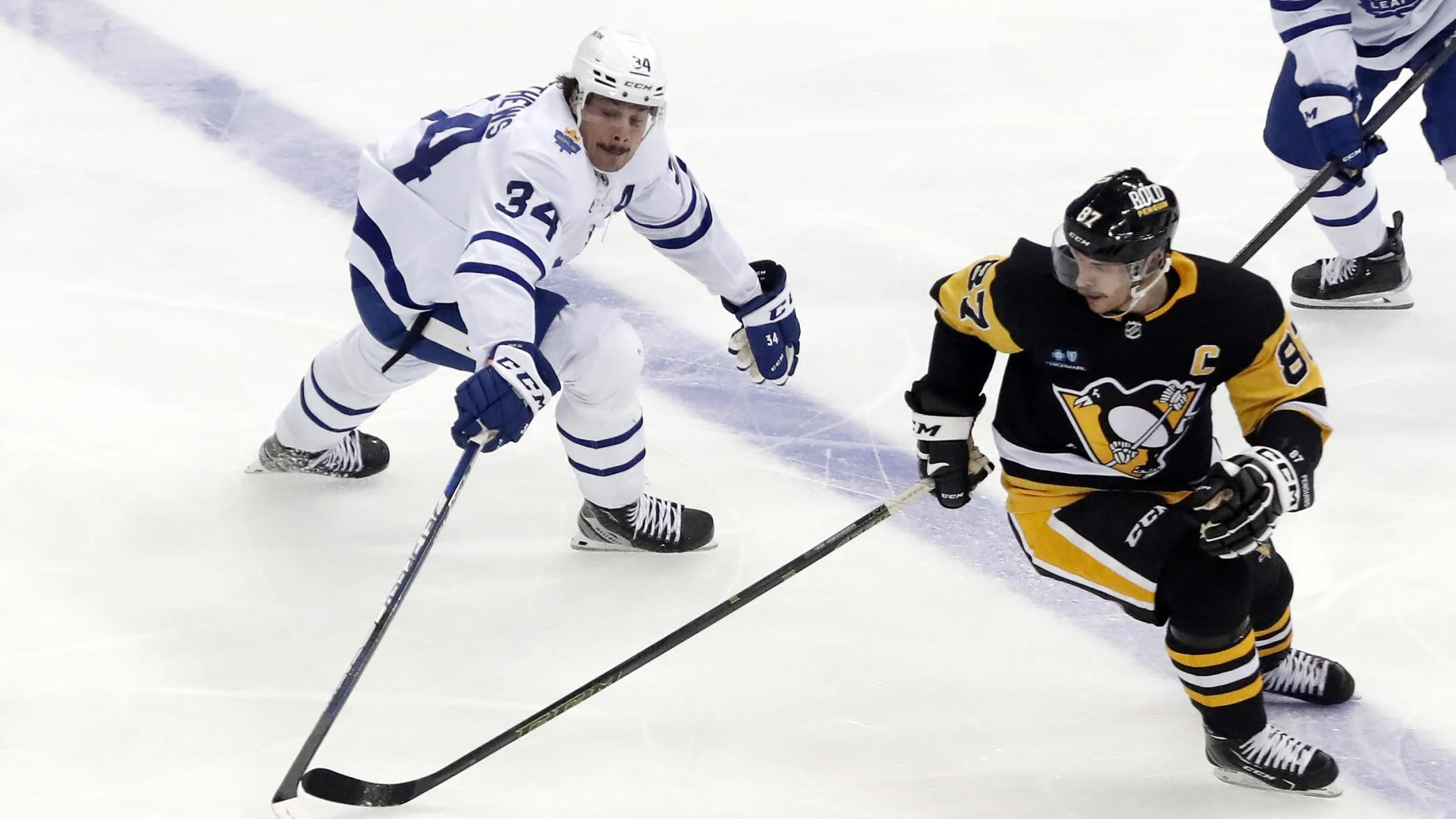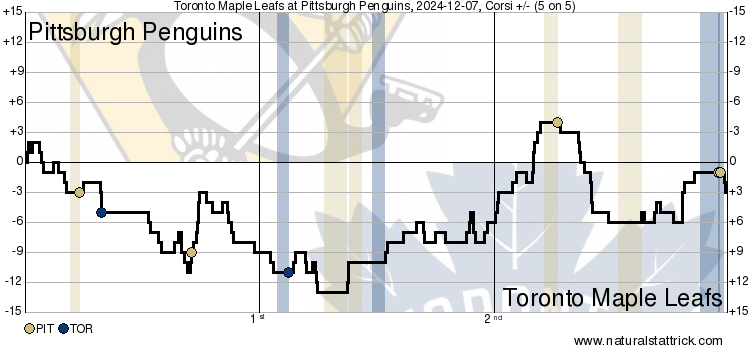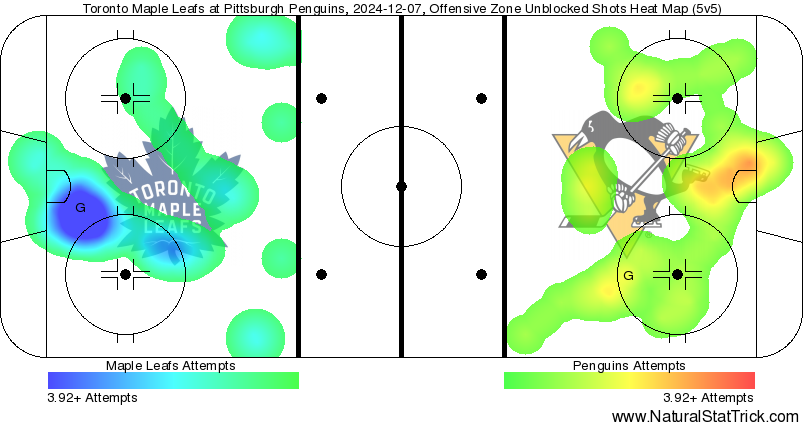The Maple Leafs have lost back-to-back times in regulation for the first time since the end of October (18 games, to be exact).
It’s a disappointing weekend, losing at home to a good Capitals team and then on the road to a bad Penguins team, collecting zero points in the process. It doesn’t get easier on Tuesday against Sheldon Keefe and the New Jersey Devils.
Results aside, the Leafs have to get back to controlling games at five-on-five. Washington tilted the ice against them, and they were barely above even against a fairly middling Penguins team in this one.
Rather quietly, the Leafs are now 4-5-2 on the road overall and have had some real stinkers against mediocre teams in the process. It’s too early to determine if this is a genuine issue or just randomness that will sort itself out as the season progresses, but it’s noteworthy to flag at this point.
Additional reinforcements are on the way, and they can’t come soon enough at this rate. They can be and are a lot better than they played this weekend, and that’s what makes it frustrating in the meantime.
Your game in 10:
1. Craig Berube was honest when assessing the last game against Washington, saying that the Capitals won more battles, skated harder, and simply played better. After that type of loss, it’s always interesting to see how the team will come out and respond. They did not start well yet again.
Berube put out the newly formed Max Pacioretty – Auston Matthews – Mitch Marner line to start the game and presumably set the tone, but Matthews lost the opening faceoff, the Penguins got it deep, forechecked the Leafs well, and hemmed them in as Joseph Woll lost his stick. It was chaotic in the Leafs‘ end.
The Leafs managed to get it out to center and get a line change going, but then Morgan Rielly iced it and the Penguins reloaded with a new line. The Leafs did generate a good fourth-line shift with some zone time, and when the top line came back out, Pacioretty made a nice play below the goal line to find Marner in front, but he shot it wide.
On the next shift, as the Penguins moved up through the neutral zone, Matthew Knies took a lazy penalty that was unnecessary. He had defensemen behind him, it was at the center ice, and he didn’t move his feet.
It was an all-around bad start to a game from the first shift on, culminating in a Leafs penalty.
2. The Leafs’ penalty kill has been excellent so far this season, but they couldn’t get the team out of the penalty unscathed. The Penguins generated some looks in the first quarter of the power play, leading to an offensive-zone faceoff that they won cleanly. Matthews took the draw; he has been good on faceoffs since returning, winning 57.4 percent, but he got cleaned out to start the game, and he got cleaned out on this one.
After the faceoff loss, the Leafs were a little discombobulated. Marner applied pressure on the puck and kept going when it went to the half-wall, which is generally what the Leafs have their forwards do, but Conor Timmins also stepped out. Timmins and Marner slightly ran into each other as a result.
The puck went back to the point, where the Penguins had all day to sift a simple shot through traffic. It deflected off Rickard Rakell and into the net.
This is the third straight game in which the Leafs have been scored on first, partly because they continually start their first few shifts poorly and instantly get tilted on the ice. They need to begin starting games better.
3. Just two minutes later, the Leafs tied the game on a shift where they earned it, as the top line dominated the shift. The sequence started with a won battle on the half-wall and getting the puck to the point, where Chris Tanev ripped a quick pass over to Oliver Ekman-Larsson on the far side. OEL had time and space to walk in, but he hit the post.
The puck bounced off the post and rimmed all the way back to Tanev, who simply did the same thing — pass it over to the left side — except this time, it found Matthews. Because it was Matthews, he drew in the attention of two Penguins defenders, which opened up OEL yet again. Matthews feathered over a backhand pass, OEL shot it again, and Marner — who was screening the goalie — banged home the rebound as he was falling down.
It’s the type of greasy, get-to-the-net goal that you love to see coming from the Leafs’ stars. I mentioned on Monday that OEL was starting to pace for a career-low year in terms of points per game, so it’s a nice bounce for him to grab an assist as well. The night before against Washington, OEL hit the post in the third period. Again, moments before this goal, he was firing good shots through. If he continues to do it, good things will continue to happen.
Marner’s goal brought him to 30 points in his last 19 games.
"MARNER ON THE SEAT OF HIS PANTS!"
Marner 10th of the Season vs Penguins courtesy of @Bonsie1951 and @Jim_Ralph. @LeafsJelly pic.twitter.com/kKvvVMiYOz
— Maple Leafs Hotstove (@LeafsNews) December 8, 2024
4. After the Leafs scored, they started stringing several good shifts together. On one fourth-line shift, they got it in deep, and the puck ended up with Simon Benoit all alone in front of the net, where he hit the post.
Right afterward, there was another shift where OEL’s shot caused problems as he tried to rip a shot pass to Tavares in front. Tavares almost scored on the initial play and on the rebound, too. The Leafs were generally controlling play, and the Penguins weren’t creating much.
Off of a defensive zone breakout, the Penguins quickly went down on a 2v2 rush. Sidney Crosby kept it and toe dragged before firing a wrist shot off the rush. It went wide, bounced off the boards hard, and kicked out right to the top of the circle, where Bryan Rust one-timed it along the ice for the 2-1 goal.
The puck found its way through traffic, but it’s not a good goal. Woll wasn’t tracking the puck well at all the entire period, and this puck went under him from a distance without a deflection. It was the Penguins’ second goal of the period on just their fifth shot.
The Leafs’ goaltending has generally bailed them out this season, so it’s tough to be too critical of it, but that was a tough start to the game for Woll. The Leafs probably didn’t deserve to be losing at the end of the first period, but they were.
5. Matthew Knies took a penalty that led to a goal against in the first period, but he earned one in the second period by winning a battle down to keep possession, leading to Kris Letang hitting Tavares away from the puck. This time, the Leafs capitalized.
The five-forward power play unit went out and went to work. With Marner at the top, he had his choice between which shooter he wanted to give the puck to, and the Penguins were spinning trying to cover it.
On the goal, Matthews walked in and took a shot, grabbed the rebound, and sent it back up to Marner, who went across to Nylander on the side. Nylander blasted home a one-timer.
It was partly the result of Tristan Jarry constantly going side-to-side as he dealt with the legitimate shooting threats on both half-walls. This unit is starting to show real signs of life, which is a promising development for the team.
Nylander 17th of the Season vs Penguins courtesy of @Bonsie1951 and @Jim_Ralph. @LeafsJelly pic.twitter.com/CZda1RST35
— Maple Leafs Hotstove (@LeafsNews) December 8, 2024
6. From there, the game started to get a bit out of hand.
First, Pacioretty took an unnecessary penalty after Kris Letang tried to hit him. It was simply undisciplined, and quietly, this has been a bubbling issue with the Leafs this year. They take a lot of penalties (12th in penalties taken per 60 minutes) with a -7 penalty differential that ranks in the bottom 10 of the league.
To the Leafs’ credit, they killed the penalty off, but as the penalty expired, the Penguins maintained pressure. There was a scrum in front, and the refs somehow picked out Pacioretty again for the lone penalty, even though Kevin Hayes was throwing glove-on punches at OEL in the scrum.
On this kill, Knies did a great job of skating the puck down the ice, circling the offensive zone, and passing it back to the Leafs’ blue line to kill time. When they snapped it back up to Holmberg, he had a 1v1 against Erik Karlsson, who took a tripping penalty.
The Leafs went to an abbreviated power play at the end of it, but they didn’t have enough time to put it together and threaten.
The penalty kill had issues in this game, but this was a good sequence by them when the game was tied.
7. Again, the Leafs got off to a bad start to the third period. Again, the tone was set by the top line, as the Penguins put the puck in deep and worked them. They need to start games and periods way better than they currently do.
If the top guys can’t do it — and they definitely couldn’t do it tonight — then they need to put together some sort of energy line that can win a faceoff, get a puck deep, and start a forecheck. They want to be a forechecking team, and the only team doing it is their opponent. That was the story of their weekend, and this was just another example.
Five minutes later, Matthews took a careless high-sticking penalty (there’s no need to go over the player with his stick there, and he made a weak play through the neutral zone to begin with). The Penguins made them pay.
The goal itself had some fortune to it as the puck deflected off Timmins’ skate right to Bunting on the backside of the play, but it’s important to highlight the Leafs’ poor structure. The Leafs have generally run an aggressive diamond penalty kill this season, but tonight, they were often in a 1-1-2. It was unrecognizable to me. The Penguins were teeing off from the half-wall, they had tons of time and space at the top of the zone, and coupled with Woll fighting it tonight, it led to two goals against and several other scrambles in the crease.
The penalty kill survived back-to-back penalties in the second and later killed another one off in the third, but they gave the Penguins far too much overall and ultimately allowed two goals against.
8. The Leafs did have a few chances quickly afterward as Nylander had some space to drive the net but couldn’t pull it to his forehand cleanly, and then probably their best chance of the period to tie came on a Knies shot in the slot that he put right off the post. Truthfully, he’s shooting over 23 percent, and some regression will come for him. This kind of felt like one of those instances; otherwise, it was there for him.
On the flip side, Woll kept the Leafs in the game on a Malkin breakaway and then by gloving the follow-up rebound chance by Drew O’Connor.
As the period went along, the Leafs were really struggling to gain the zone. They weren’t getting enough off the forecheck, and they couldn’t sustain any real pressure or threaten offensively. Berube cut the bench down and was trying to shuffle things around; for example, Nylander took a shift with his brother and Minten, while Knies moved back up to the top line with Matthews and Marner.
The inability to turn it up offensively is becoming a bit of a story for this team. They have too much talent for a one-goal lead for 15 minutes to feel insurmountable, but right now, that’s exactly how it’s coming across.
9. The Leafs received a lifeline at the end of the game as Holmberg snapped his head back and drew a high-sticking penalty that shouldn’t have been called. The five-forward unit came out and snapped pucks around, but they couldn’t get shots through, and then the Leafs pulled the goalie to make it a 6v4.
They generated a great look as the Penguins pulled high to challenge the Leafs’ top three playmakers. The Leafs countered by bumping it low to Rielly, who found Tavares in the slot, but Tavares couldn’t bury the one-timer.
That was the Leafs’ best chance to tie it. Moments later, after an errant Nylander pass cleared the zone, he made a weak play on the next entry before Tavares lost the battle on the loose puck, leading to an empty-net goal to seal the game.
The Penguins would add another empty-net goal for good measure afterward to win by three.
10. The Leafs are still fighting injuries, which really showed this weekend. Jake McCabe is clearly a big absence. They are struggling to break out, and now they have too many defensemen playing higher than they should, as OEL is up on the top pairing, Philippe Myers is technically in the top four, etc.
At forward, the Leafs were on the second half of a back-to-back and playing their fourth game in six nights overall. They didn’t have a single player in their bottom six play more than Steven Lorentz’s 10:47. No offense to Lorentz, but if he is seventh amongst the forwards in ice time, the team has a real problem or a blowout on its hands. The Leafs’ top players looked gassed as the game went along, impacting their inability to make a proper push to tie it.
It was also noteworthy that the Leafs got absolutely cleaned out in the faceoff circle all night. Tavares *led* their centers with a 38.1 percent faceoff percentage. They lost every single critical draw, especially on special teams, and for a team that was struggling to create offense and had half a forward group doing nothing, starting with the puck a bit more would have helped. At one point in the second period, Tavares took a defensive-zone faceoff with the fourth line because Dewar couldn’t win one.
The Leafs have to get healthy, and they have to get rolling again. Right now, it seems to be catching up to them.















![John Gruden after the Leafs prospects’ 4-1 win over Montreal: “[Vyacheslav Peksa] looked really comfortable in the net… We wouldn’t have won without him” John Gruden, head coach of the Toronto Marlies](https://mapleleafshotstove.com/wp-content/uploads/2025/09/gruden-post-game-sep-14-218x150.jpg)




















